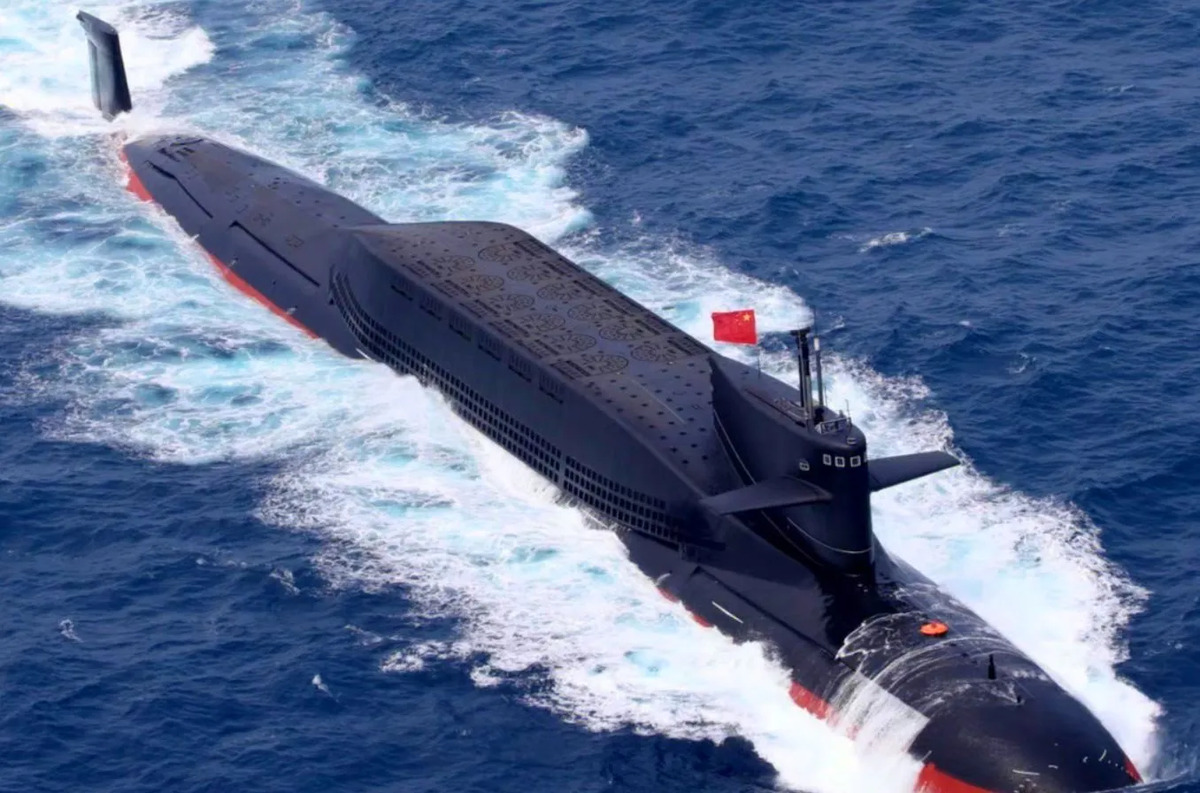China, India Submarine Accident: Navy Officials Decode Western Claims Of “Open Hatch” Sinking Theory

US officials have claimed that a simple yet grave operational error caused the sinking of a Chinese Zhou-class nuclear submarine, an “open hatch.”
If true, this would be a damning indictment but are Western observers telling the whole story or making unfounded claims just to mock Beijing? The question is worth exploring as earlier similar allegations leveled against India after a submarine mishap was found to be untrue.
Satellite images had revealed at least four large cranes attempting salvage efforts in June this year on the partially submerged Type 041 Zhou-class submarine in a harbor in Wuhan, indicating a major setback to the People’s Liberation Army Navy’s (PLAN) underwater fleet.
This alleged ‘operator error’ that caused the mishap raises serious questions about the training and safety protocols the PLA Navy follows, even as it makes significant strides in its submarine capabilities with the construction of three new Shang III cruise missile-firing nuclear submarines.
On October 30, The Washington Times reported that these vessels are currently undergoing sea trials and certification, indicating that the operational deployment of the Shang III submarines is anticipated within the next one to two years.
This represents a notable advancement in China’s attack submarine program, as “these are the first cruise missile submarines in the Chinese inventory,” a defense official said.
AfriPrime App link: FREE to download...
https://www.amazon.com/Africircle-AfriPrime/dp/B0D2M3F2JT
While discussing these developments, the US officials also provided insights into the Zhou-class submarine mishap, which was characterized as the result of an “operator error. ” Officials confirmed that ‘an open hatch’ was the primary cause of the flooding.
“They goofed,” the official said, adding that the mishap should not be interpreted as indicative of a broader systemic failure in Chinese submarine construction practices.
Meanwhile, former US Navy submarine warfare officer Thomas Shugart commented on the incident, suggesting that the US Department of Defense’s understanding of the circumstances surrounding the Zhou-class submarine mishap likely stems from various intelligence sources beyond commercial satellite images.
Addressing the reported error of leaving a hatch open, Shugart speculated that the situation was likely more complex. He pointed out that most hatches are not typically located below the waterline, as they are designed to keep water out.
He suggested that the submarine might have been in a state where adjustments in its trim or draft—possibly as part of maintenance or testing—allowed a hatch, normally above the waterline, to come into contact with the water, leading to flooding.
Shugart also cited a similar incident in US Navy history to highlight how such mishaps are not unheard of. He recalled the sinking of the USS Guitarro, a Sturgeon-class nuclear-powered attack submarine, on May 15, 1969, during its construction at the Mare Island Naval Shipyard in California.
The USS Guitarro incident was caused by two independent civilian construction teams working on the vessel. One team filled tanks at the rear while the other filled tanks at the front, resulting in an imbalance and uncontrolled flooding.
Shugart emphasized that if the Zhou-class submarine’s mishap involved similar dynamics, it would be essential to examine underlying systemic issues. Questions about the adequacy of training, coordination, and operational discipline could reveal gaps in safety protocols.
In the case of the USS Guitarro, the incident led to a congressional commission and a comprehensive report that outlined what went wrong and proposed solutions.

Shugart noted that a similar level of inquiry could be invaluable in uncovering the full story behind the Chinese submarine incident, although such details may never be made public.
However, military analysts are circumspect before wholeheartedly supporting this ‘open hatch’ theory in the absence of clinching evidence. They point out that the Chinese Navy, already the world’s largest naval force with a rapidly expanding underwater fleet, is unlikely to commit such a simple yet grave and costly error.
They also point out that similar allegations were made against the Indian Navy after a submarine mishap in 2017, which were later found to be untrue.
A retired Indian Naval officer linked with INS Arihant told EurAsian Times on condition of anonymity that it is “very improbable that leaving a hatch open would lead to sinking of a submarine in the harbor because most hatches are above the waterline and therefore, some other activity must have been in progress concurrently. Usually, in such whole-ship evolutions or activities, every compartment in a submarine would be manned. If it is a planned activity, all compartments would be isolated by shutting down their access hatches, thereby bringing an assured degree of watertightness.”
He further pointed out, “Mistakes are bound to happen. World over, submariners are amongst the most professional and trained manpower in any navy. Hence, such oversight of opening hatches while adding ballast and not having compartments isolated is unheard of and, in my opinion, quite improbable.”
However, the former Indian Navy official added, “If indeed this is true, then yes, the PLAN can be called out for inadequate and unsafe procedures or errors due to an inexperienced crew. Here again, navies select the first-of-the-class crew with great attention to detail, especially their experience, professional standing, alacrity, intelligence, etc. It is an honor to be a part of the commissioning crew.”
INS Arihant ‘Accident’
The sinking of China’s Type 041 Zhou-class submarine, attributed by the US defense officials to an ‘operational error’ involving an open hatch, brings to mind a similar mishap involving India’s indigenous nuclear submarine, INS Arihant, which suffered damage purportedly due to a human error in 2017.
In 2018, the Hindu reported that the INS Arihant experienced damage when water entered its propulsion compartment after a hatch on the rear side was mistakenly left open while the submarine was docked.
This narrative quickly gained traction, especially among Western media outlets and social media users, who seized the opportunity to question the Indian Navy’s operational discipline and training adequacy.
However, this assertion was later debunked, revealing the dangers of sensationalism and the criticality of accurate information while discussing security issues.
Subsequently, a report by The Economic Times clarified the situation, asserting that the INS Arihant does not have any hatches in the area where the alleged flooding occurred.
INS Arihant is based on a Russian double-hull design that features a sealed nuclear reactor compartment. While the submarine’s core is designed for a limited operational lifespan and will eventually require refueling, it was reported that no hatches exist that would allow seawater ingress in the propulsion compartment.
There are no external hatches in the section housing critical components such as the steam turbine, gearbox, generator, and propeller shaft, making it virtually impossible for seawater to enter the submarine under normal conditions.
Additionally, the report emphasized the technological advancements integrated into modern submarines, which are equipped with numerous sensors and warning systems designed to alert crews to potential hazards, including open hatches.
Apparently, no heed was paid to the basic design elements of the Indian submarine before Western observers concluded that the mishap was caused by an ‘open hatch.’ Now, the Chinese Navy is blamed for a seemingly similar human error. However, as in the case of the Indian submarine, it would not be prudent to follow this theory until some clinching evidence is provided.
This contemptuous commentary by the West on the Indian and Chinese Navy has striking parallels in the way Palestinian-American author Edward Said has once defined ‘Orientalism.’ In his 1978 book by the same name, Said illustrated how the West has always portrayed the East in a contemptuous and problematic way.
His book analyzed how Western experts, or “Orientalists,” have created a view of the East based on essentialist assumptions of Western superiority. Said further argued that this view has been used to justify Western colonialism and imperialism.
Similarly, some Western military observers want us to believe that the Indian and Chinese naval forces, despite their impressive expansion and modernization efforts, are stupid enough to destroy their expensive submarines just by leaving an ‘open hatch.’ Indeed, this is a very sad commentary on the professionalism of the naval forces of India and China.
That being said, this does not mean that an unbiased inquiry is not required, as the implications of these incidents extend beyond mere operational failures. They serve as critical reminders of the importance of rigorous training, continuous evaluation of safety protocols, and the necessity of a robust culture of accountability within naval operations.
AfriPrime App link: FREE to download...
- Questions and Answers
- Opinion
- Story/Motivational/Inspiring
- Technology
- Art
- Causes
- Crafts
- Dance
- Drinks
- Film/Movie
- Fitness
- Food
- Games
- Gardening
- Health
- Home
- Literature
- Music
- Networking
- Other
- Party
- Religion
- Shopping
- Sports
- Theater
- Wellness
- News
- Culture
- War machines and policy

